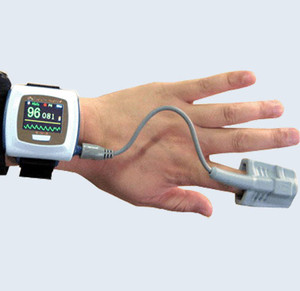Overnight pulse oximeters are medical devices used to noninvasively monitor oxygen saturation in the body of a patient. This equipment is used in a medical method called pulse oximetry. The equipment was invented by a German physician in the year 1935. Since that first invention, there have been many other physicians who have added components to the device with a bid to make it more effective.
Oximetry uses 2 tiny light emitting diodes, LEDs that face a photo-diode on the other surface through a translucent portion of the body. Earlobes, fingerprints, or feet if it is an infant in question can be utilized. One diodes is red and is made with wavelength of 660 nm. The other one is usually infrared with 940, 910, or 905 nm of wavelength. The velocity of absorption of the 2 wavelengths varies considerably between deoxygenated and its oxyhaemoglobin form.
Due to the variations in the absorption of the red and infrared wavelengths, the oxyhemoglobin and deoxyhemoglobin ratio can be calculated. At the wavelengths of 590 and 805 nm, the absorbance of deoxyhemoglobin and oxyhemoglobin is similar. Earlier equipment used these wavelengths to correct hemoglobin concentration.
The monitored signal changes over time with heart beats since arterial blood vessels constrict and expand with the heartbeat. By assessing the varying portion of the absorption spectrum alone, a monitor is capable of leaving out nail polishes or other tissues. By leaving out polish on fingernails and other tissues, monitors can capture absorption that is only caused by blood in arteries. It is therefore a vital requirement to identify a pulse in this practice, otherwise the exercise will fail.
The monitors that check the levels of oxygen in blood display the composition of hemoglobin in arterial vessels in oxyhemoglobin configuration. In individuals who do not experience hypoxic drive problems and COPD, the ordinary acceptance range is between 95 to 99 percent. Individuals with hypoxic problems observe values between 89 to 94 percent. Values of a hundred percent are an indication of carbon (II) oxide poisoning.
Oximetry is different from other methods of monitoring the level of oxygen in blood because it is an indirect approach. The equipment can be integrated into multi-parameter patient monitoring systems. Most of them also indicate the pulse rate of an individual under monitoring. Overnight pulse oximeters are normally portable so that they can be carried into homes for home-based medication. They are small and operate on batteries.
These devices can be used in a wide range of applications and environments. They are used in hospital wards, emergency units, urgent care facilities, unpressurized aircrafts, and intensive care units among many others. They are used to assess the need and efficiency of supplemental oxygen to people. The device however cannot determine the rate of metabolism of oxygen in the body. For this reason, it should be used with carbon dioxide monitoring devices complimentarily.
Overnight pulse oximeters are significant for people in critical medical state. They alert health workers of abnormalities in amounts of oxygen in sick people. Technological improvement has rendered it possible to remotely control them for purposes of efficiency and convenience.
Oximetry uses 2 tiny light emitting diodes, LEDs that face a photo-diode on the other surface through a translucent portion of the body. Earlobes, fingerprints, or feet if it is an infant in question can be utilized. One diodes is red and is made with wavelength of 660 nm. The other one is usually infrared with 940, 910, or 905 nm of wavelength. The velocity of absorption of the 2 wavelengths varies considerably between deoxygenated and its oxyhaemoglobin form.
Due to the variations in the absorption of the red and infrared wavelengths, the oxyhemoglobin and deoxyhemoglobin ratio can be calculated. At the wavelengths of 590 and 805 nm, the absorbance of deoxyhemoglobin and oxyhemoglobin is similar. Earlier equipment used these wavelengths to correct hemoglobin concentration.
The monitored signal changes over time with heart beats since arterial blood vessels constrict and expand with the heartbeat. By assessing the varying portion of the absorption spectrum alone, a monitor is capable of leaving out nail polishes or other tissues. By leaving out polish on fingernails and other tissues, monitors can capture absorption that is only caused by blood in arteries. It is therefore a vital requirement to identify a pulse in this practice, otherwise the exercise will fail.
The monitors that check the levels of oxygen in blood display the composition of hemoglobin in arterial vessels in oxyhemoglobin configuration. In individuals who do not experience hypoxic drive problems and COPD, the ordinary acceptance range is between 95 to 99 percent. Individuals with hypoxic problems observe values between 89 to 94 percent. Values of a hundred percent are an indication of carbon (II) oxide poisoning.
Oximetry is different from other methods of monitoring the level of oxygen in blood because it is an indirect approach. The equipment can be integrated into multi-parameter patient monitoring systems. Most of them also indicate the pulse rate of an individual under monitoring. Overnight pulse oximeters are normally portable so that they can be carried into homes for home-based medication. They are small and operate on batteries.
These devices can be used in a wide range of applications and environments. They are used in hospital wards, emergency units, urgent care facilities, unpressurized aircrafts, and intensive care units among many others. They are used to assess the need and efficiency of supplemental oxygen to people. The device however cannot determine the rate of metabolism of oxygen in the body. For this reason, it should be used with carbon dioxide monitoring devices complimentarily.
Overnight pulse oximeters are significant for people in critical medical state. They alert health workers of abnormalities in amounts of oxygen in sick people. Technological improvement has rendered it possible to remotely control them for purposes of efficiency and convenience.













.jpg)






0 comments:
Post a Comment